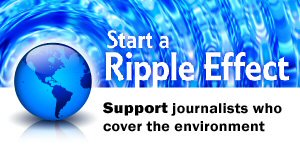SEJournal Online is the digital news magazine of the Society of Environmental Journalists. Learn more about SEJournal Online, including submission, subscription and advertising information.
By BILL DAWSON
Jane Kay is one of environmental journalism's most honored and respected reporters. The San Francisco Chronicle's environment writer, she is a two-time winner of the Scripps Howard Foundation's Edward J. Meeman Award.
Last September, for a diverse portfolio of articles, she received the first-place award in the "Outstanding Beat Reporting - Print" category in SEJ's 6th Annual Awards for Reporting on the Environment. The judges said:
"In a very strong contest category, Jane Kay's stories stand out as exemplars of the very best of what environmental beat reporting can be. The seven stories she submitted range widely in tone (from agenda-setting news to inspirational features) and subject (from rising sea levels to toxic toys), but what they all share is Kay's careful reporting, smart organization and clear, confident voice."
At the Chronicle, Kay focuses her reporting efforts on global warming, biological diversity and environmental health, including chemicals in people, wildlife and consumer products.
She taught environmental reporting at the University of California at Berkeley from 1991 to 1998, then directed the Graduate School of Journalism's Program in Environmental Journalism until 2003.
Other awards include the national Sigma Delta Chi Award for Public Service and the Don Bolles Memorial Award for Investigative Reporting in 1986 for uncovering decades of solvent pollution in Tucson's drinking water, as well as the National Press Club's Robert L. Kozik Award for environmental excellence in 1994 for her seven-part series, "Bay in Peril.''
Q: People have taken a lot of different paths into environmental journalism. When and how did you first get involved with the beat?
Kay: In the late 1970s, I was working at the Arizona Daily Star in Tucson as a feature writer. I was doing a story about child labor near Phoenix in Maricopa County. Children 8 years old were in the fields tying green onions alongside their parents. I'd go out in the morning to get photographs and interviews, and saw and smelled the crop dusters flying overhead with the drift landing on the people. I saw the barrels of chemicals leaking into the irrigation ditches where people bathed. I convinced my editor to let me trade with a reporter who was on news side and wanted to write feature stories.
I started the environmental beat at the paper in 1979. My first stories were on pesticides, including on the grants that University of Arizona faculty received from chemical companies for research on products that would probably never be approved for U.S. use. I got my feet wet in a hurry. That year I got a tip about tritium, radioactive hydrogen, escaping from a watch dial factory in the middle of the city. I found, somewhat laboriously, that the tritium had contaminated neighbors as well as the food in the kitchen supplying cafeterias in Tucson's largest school district. After months of stories, then-Arizona Gov. Bruce Babbitt ordered the National Guard to remove casks of tritium from American Atomics Corp. and store them in bunkers near Flagstaff.
Q: Early recognition for your reporting came in the form of major national awards for uncovering decadeslong contamination of Tucson's drinking water with solvents. Have you continued to follow the solvent issue closely over the years? In hindsight, are there things you would now do differently if you were approaching the same story for the first time today?
Kay: The story of Tucson's contaminated aquifer, which the Arizona Daily Star broke in 1985, continues today as the city faces future shortages in good quality drinking water.
In hindsight, I can't believe that I conducted my own year-long health study on exposure to TCE, or trichloroethylene. The solvent had been in the drinking water for at least 20 years, delivered directly to much of the southside near the airport, mixed Latino and Anglo neighborhoods. I interviewed more than 500 people. On a specially designed computer program, I logged in all the data: name, age, year of diagnosis of illness, address, how long they lived there, where they attended school, and relatives. I compared cancers to what would be expected in the census tracts, and found some excess cases.
I felt that I had to do it because no one else would. I couldn't drum up interest from the Arizona Department of Health Services or the (U.S.) Centers for Disease Control and Prevention. Both agencies denied that TCE was harmful. Now it's categorized as a probable human carcinogen.
Since then, thousands of residents have shared in millions of dollars in settlements of lawsuits alleging that they have suffered health problems from unknowingly drinking water tainted with the TCE plume coming from the site of Hughes Aircraft Co., a former U.S. Air Force contractor, and other sources near the airport.
When I came to California in 1986, I wrote about the underground plumes of solvents in Silicon Valley as well as selenium from agricultural runoff tainting surface water. In northern California, the public doesn't rely so heavily on groundwater. Now I write many more stories about mercury from old mines leaking into San Francisco Bay and contaminating birds, marine mammals and the fish that people would very much like to eat.
Q: What are the most significant changes you've witnessed in environmental reporting over the course of your career – changes for good or bad?
Kay: The changes have been mostly for the good, I'd say. Now environmental stories aren't segregated but are integrated throughout the paper. It's not just me writing about the environment.
We have business reporters covering the economics and technology of clean energy and how the environment plays into a successful season at a ski resort. Home and garden sections emphasize eliminating chemicals in backyards and in consumer products. Food sections include stories on organic, slow food and sustainability trends. Feature writers take on Hollywood celebrities, kids, students and religious groups supporting a green movement and how the new commitment has pervaded the culture. Political writers report on fights over environmental laws in the state legislatures and Congress among auto, power, chemical and other industries and consumer and conservation groups.
The Bush administration's stance figures heavily into the stories on a national level, particularly regarding global warming, endangered species and states' rights over stricter regulation.
On the news side, transit and transportation writers link the commute to air quality and fuel use. Architectural writers cover green buildings. The environment has come into its own, and the front pages reflect it.
Q: Has the way that you carry out your duties at the San Francisco Chronicle been affected by all the major changes going on in the newspaper industry and the news media in general? In a related vein, what are the biggest challenges – now and in the future – that you see these changes creating for journalists covering the environment?
Kay: Yes, definitely. We are all struggling to do what The Associated Press has always done – get something that isn't wrong up on the wire immediately. Here's the challenge: Do we lift off a press release? No, we can't do that. So we have to make a few calls on a breaking story just to make sure we've covered our bases before we put the story online. Is that taking away from the quality of reporting for the finished daily story? Environmental stories have many sides, much context and a need for clarity. The challenge is to do it all, to get a teaser story online and produce a whole, balanced piece for the morning.
Q: Now, I'd like to ask a few questions about the portfolio of your articles from 2006 and 2007 that won first place for outstanding beat reporting by a print journalist in the 2007 SEJ awards. Please pick one story from that group that especially stands out in your mind – because it's the one you're proudest of, or drew the biggest reader response, or was the toughest to report and write, or for some other reason. How did that story come about? What were the particular challenges and satisfactions in doing it?
Kay: Hands down, that would be the toxic toy story. It was the toughest to write and certainly drew the most response.
Environmentalists had been pushing the state legislature to pass a law limiting two little-known chemicals in children's toys, phthalates, a plastics softener, and bisphenol A, a plastics hardener. While the legislature demurred, San Francisco supervisors went ahead and passed it. I suggested to my editors that we pay for tests on common toys at labs with the capability to look for the chemicals. They agreed, and we did it. The lab found some high levels, including a rubber ducky and Random House bath books.
I found it immensely interesting to research the health effects of the two types of chemicals, and present the findings of the scientists who had concerns and the manufacturers who argued that they were okay. We could also delve into how the city would carry out such a law and what the retailers would do.
In October, the California Legislature banned phthalates in toddlers' toys and the governor signed it into law, making California the only state to prohibit the chemicals in child-care products outside of the European Union.
Q: Two of the seven articles in the portfolio were "success stories." One was about a 30-year reunion of scientists whose research as college students was instrumental in saving California's Mono Lake from environmental degradation. The other was a profile of a San Francisco environmentalist, on the occasion of his 100th birthday, who is credited with preserving more than 100 million acres in a natural state. Do you think it's important, generally speaking, for environmental journalists to highlight such successes as well as problems?
Kay: Readers definitely like success stories. And one does begin to feel like Debbie Downer with all the bad news that we deliver. But I don't write good-news stories just to provide a lift or even a mix.
The San Francisco environmentalist who has saved 100 million acres in Alaska and the West as a Sierra Club leader turning 100 years old and the original Mono Lake scientists reuniting for the first time after 30 years were news stories with honest angles. I grab them when I see them.
Q: A couple of your portfolio articles involved requests by you and your newspaper for experts to produce technical information that you then based stories on – the tests of toys and maps to show which areas around San Francisco Bay would be submerged if global warming boosts tides by three feet. Do you make such requests regularly? Do you expect to do it more in the future? Any pointers or cautions for other journalists and news organizations contemplating taking this route to augment their reporting?
A: Yes, we do seek help. We cannot test toys ourselves. We do not have access to all the data points and technology to be able to produce maps showing the effects of sea level rise. But we can work with the agencies or other experts to try to gain answers to important questions that we pose as journalists.
People with data are often only too glad to try to use their information in ways that will further public education. Needless to say, you have to select capable scientists or you're in a heap of trouble.
Q: Do you have any advice for young journalists who are starting to cover environmental issues today – or who want to cover them?
A: Yes, don't be deterred by your ignorance. Keep asking questions, and find scientists who are respected in their fields, honest and quotable. You can't possibly be an expert in geology, toxicology, oceanography, biology and atmospheric physics – so it's all right if you majored in English. I learned on the job about tritium, TCE, uranium, cyanide, mercury, phthalates and dozens of other chemicals that I couldn't pronounce. Tackle the tough stuff, and try to write stories that answer the obvious questions: Does it hurt us? Is it illegal? How can we do it better?
Bill Dawson, SEJournal's assistant editor, is a Houston-based freelancer who also teaches at Rice University. He formerly wrote about environmental issues for the Houston Chronicle and other news organizations.












 Advertisement
Advertisement 



